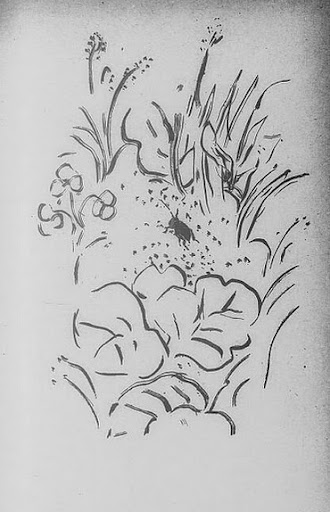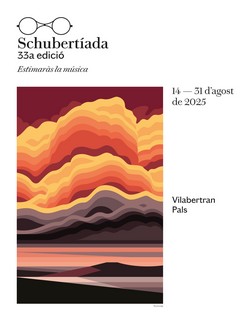
The cricket - P. Bonnard (illustration for Histoires naturelles)
In 1896, Jules Renard published Histoires naturelles (Nature stories), a book of stories whose main characters were animals: hens, turkeys, ducks, cocks, peacocks, pigeons, swans, dogs, cats, cows ... a long list. The book (and the animals’ list) was expanded in later editions until 1909; Renard died the following year. The first story is called Le chasseur d'images (Hunting for Pictures) and explains how someone leaves his house in the morning ready to observe everything he comes across along the day: “les yeux servent de filets où les images s'emprisonnent d'elles-mêmes” (the eyes act as nets where images are trapped). When he returns home, before bedtime, he examines those images. Then, we begin to read descriptions of the images, each one a story; most are short and others, hardly a line. The book is a description of nature, a sharp, fun glance; I haven't read all stories but as far as I know, it's a lovely book. For instance, here we are “The Butterfly”: "Ce billet doux plié en deux cherche une addresse de fleur” (That love letter, folded in two, looking for a flower's address).
Ravel chose five of these texts for his Histoires naturelles, premiered in 1907. The five animals that became songs were the peacock, the cricket, the swan, the kingfisher and the guinea fowl. Five birds and one insect included in our list of bugs. I haven't been able to verify this fact, maybe some of you could, but it seems that Renard didn't like music and the fact that some of his stories turned into songs really bothered him.
What we know for sure is the reaction of music critics in the songs premiere, between bewildered and irate. Detractors said that the work was more suitable for music-hall than for a serious hall, among other things because Ravel dared to make the singer not to articulate final "e", as in spoken language. On the contrary, people in favour, once recovered from amazement, emphasized Ravel's talent as a narrator. The latter is precisely what I like about these songs: I don't think Ravel intended to be humorous; he, instead, tries to be serious about a humorous story. I'm afraid I'm not making myself clear as I should...
First, let's pay attention to the text of our song, that describes the movements of a cricket. It’s done in a way that remind us of a meticulous person who is getting ready to go to bed: he checks that everything outside is in order, he closes the door, he winds up his clock and looks for a place where noise won’t disturb him. Now, let's turn to music: the singer's sentences are short, the piano plays those different noises made by the cricket, there's a sudden silence and then a long sentence that closes the song, when the cricket is already sleeping. If we listen to the song without knowing the words, it doesn't s necessarily seem a fun song. But it's fun. The baritone Pierre Bernac, in his book "The Interpretation of French Song", says that the tempo indications must be accurately followed, without any modification; everything has to be so precise that it appears that the singer is improvising, which should be the final effect.
I hope you enjoy Le Grillon. I'm sharing the version of the baritone Stéphane Degout accompanied at the piano by Hélène Lucas.
Ravel chose five of these texts for his Histoires naturelles, premiered in 1907. The five animals that became songs were the peacock, the cricket, the swan, the kingfisher and the guinea fowl. Five birds and one insect included in our list of bugs. I haven't been able to verify this fact, maybe some of you could, but it seems that Renard didn't like music and the fact that some of his stories turned into songs really bothered him.
What we know for sure is the reaction of music critics in the songs premiere, between bewildered and irate. Detractors said that the work was more suitable for music-hall than for a serious hall, among other things because Ravel dared to make the singer not to articulate final "e", as in spoken language. On the contrary, people in favour, once recovered from amazement, emphasized Ravel's talent as a narrator. The latter is precisely what I like about these songs: I don't think Ravel intended to be humorous; he, instead, tries to be serious about a humorous story. I'm afraid I'm not making myself clear as I should...
First, let's pay attention to the text of our song, that describes the movements of a cricket. It’s done in a way that remind us of a meticulous person who is getting ready to go to bed: he checks that everything outside is in order, he closes the door, he winds up his clock and looks for a place where noise won’t disturb him. Now, let's turn to music: the singer's sentences are short, the piano plays those different noises made by the cricket, there's a sudden silence and then a long sentence that closes the song, when the cricket is already sleeping. If we listen to the song without knowing the words, it doesn't s necessarily seem a fun song. But it's fun. The baritone Pierre Bernac, in his book "The Interpretation of French Song", says that the tempo indications must be accurately followed, without any modification; everything has to be so precise that it appears that the singer is improvising, which should be the final effect.
I hope you enjoy Le Grillon. I'm sharing the version of the baritone Stéphane Degout accompanied at the piano by Hélène Lucas.
Le Grillon
C’est l’heure où, las d’errer, l’insecte nègre revient de promenade et répare avec soin le désordre de son domaine.
D’abord il ratisse ses étroites allées de sable.
Il fait du bran de scie qu’il écarte au seuil de sa retraite.
Il lime la racine de cette grande herbe propre à le harceler.
Il se repose.
Puis il remonte sa minuscule montre.
A-t-il fini ? Est-elle cassée ? Il se repose encore un peu.
Il rentre chez lui et ferme sa porte.
Longtemps il tourne sa clé dans la serrure délicate.
Et il écoute :
Point d’alarme dehors.
Mais il ne se trouve pas en sûreté.
Et comme par une chaînette dont la poulie grince, il descend jusqu’au fond de la terre.
On n’entend plus rien.
Dans la campagne muette, les peupliers se dressent comme des doigts en l’air et désignent la lune.
D’abord il ratisse ses étroites allées de sable.
Il fait du bran de scie qu’il écarte au seuil de sa retraite.
Il lime la racine de cette grande herbe propre à le harceler.
Il se repose.
Puis il remonte sa minuscule montre.
A-t-il fini ? Est-elle cassée ? Il se repose encore un peu.
Il rentre chez lui et ferme sa porte.
Longtemps il tourne sa clé dans la serrure délicate.
Et il écoute :
Point d’alarme dehors.
Mais il ne se trouve pas en sûreté.
Et comme par une chaînette dont la poulie grince, il descend jusqu’au fond de la terre.
On n’entend plus rien.
Dans la campagne muette, les peupliers se dressent comme des doigts en l’air et désignent la lune.
If you need an English translation please visit this link














Comments powered by CComment